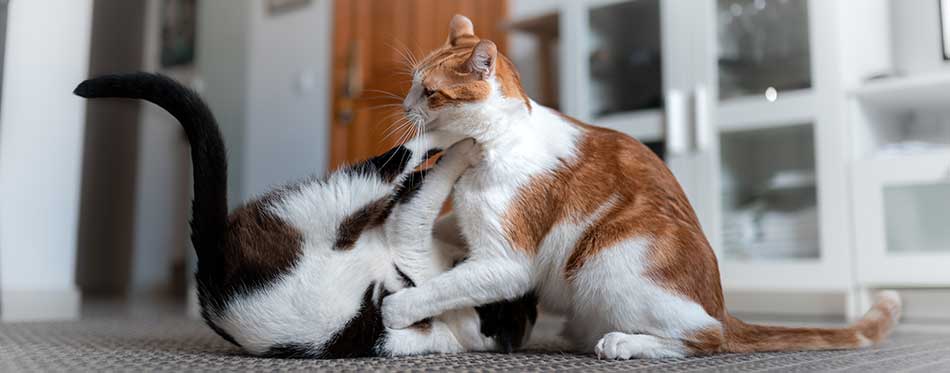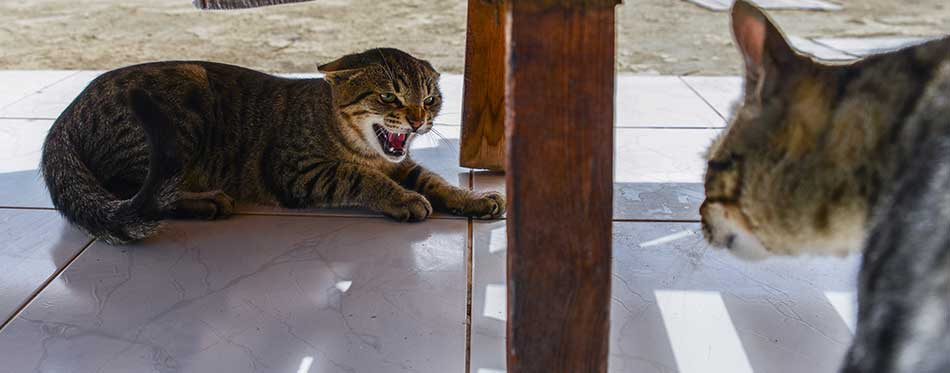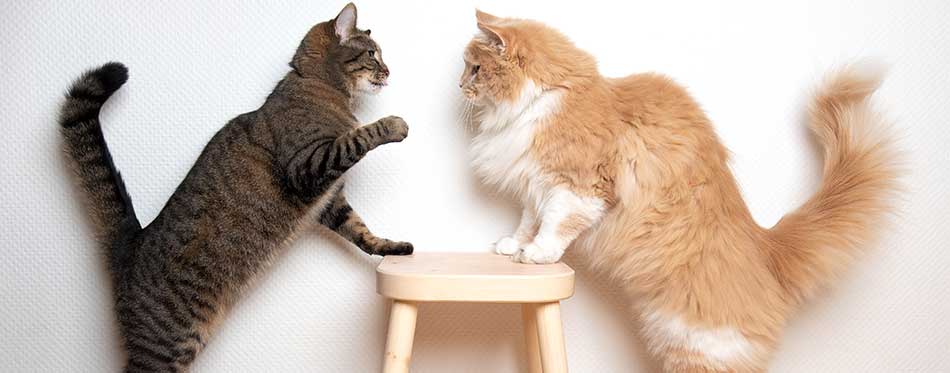When it comes to cats, two playing cats can look like two fighting cats. This is because play fighting in felines looks very aggressive to cat owners, even though the cats won’t actually be doing any damage to each other. Between the growling, batting, and biting, adult cats have the potential to scare each other and hurt each other, so it’s up to you to learn your cats’ body language and separate them when needed.
Cat behavior is very instinctual. Play aggression is normal because they have teeth and claws and that’s what they use to hunt. When a cat is playing, they’re often practicing their hunting skills, which is why cats play fight so often. They’re practicing and bonding with each other at the same time.
Thankfully, the body language of anyone cat will give away how they’re feeling in that situation. This will help you determine whether your cats are playing or fighting.

Signs Your Cats Are Playing
The following list contains various body language that you can look for when you want to know if your cats are playing or fighting. These are indicators that it’s playtime:
- Your cats are taking turns to “attack” each other.
- They’re wrestling, and often switch places.
- They take breaks between “attacks”.
- Their ears are pointed forward.
- Their tail is standing straight in its normal, relaxed position or is lazily swaying from side to side in a sweeping motion.
- Their bodies are relaxed or they have their bodies positioned forward towards their current “target”.
- They’re mouthing or biting at the other cat but not causing any harm.
Cats may also jump on each other, chase each other around your home, and hiss at each other. Play fighting like this ends fairly quickly, usually within a few minutes when one cat wants to settle down and finds somewhere comfortable to nap.
It’s likely that a younger cat will try and play with a senior cat because they want to bond with them and get to know them. Younger cats can be seen as human teenagers, testing the limits of the adult cat’s patience. This is also why two younger cats fighting can look very aggressive – they have sharp claws and they aren’t quite used to them yet.

Signs Your Cats Are Fighting
On the other hand, we have cat-fighting behaviors. When a catfight breaks out, it’s aggressive, and cat owners often feel an innate need to break it up before someone gets hurt. The more you observe your cats, the more in-tune you’ll be with their behavior and body language. Cats going for a real fight with each other may look like this:
- Low body posture.
- They’re keeping their tail erect or it’s rapidly swinging.
- Ears turned backward and flat against their head.
- Puffed up fur, most likely their tail.
- Hissing with bared teeth while leaning away from the other cat.
- Two cats circling each other before attacking.
- Aggressive sounds, such as low warning growls.
Both playing and fighting are common in multi-cat households. Rough play is normal, which includes the typical cat mock fight and play bites. Most cats exhibit this behavior, and it’s mostly fine as long as the same social group of cats doesn’t get too aggressive in their play sessions and turn it into a fight.
Another warning to watch out for here is cats that fight so often that they hurt each other or the other cats in your home are hiding because of the behavior of an aggressive cat. When this occurs, don’t immediately give up on your aggressive cat and take them to a shelter! Aggressive cats can be socialized and there are plenty of calming cat aids out there that can help with negative behavior. Give your cats a chance.
What Should I Do If My Cat Fights Another Cat?
Though it’s tempting to break up every fight you see, it can be kind of dangerous for a human to get in between two fighting cats – even if they’re just mock fighting. We don’t think we need to remind you that your cats, as cute as they are, have much sharper nails and teeth than you. They can do some serious damage to your skin if they’re not in the mood to mess around.
Before stopping two cats during a fight or play session, you should always spend a few moments to figure out if they’re actually fighting or not. Play fighting, in 99% of circumstances, will not result in one of your cats getting injured. There are accidents, of course, but by stopping them from having these little play fights, you’re putting a halt to their natural instincts.
Once you’ve observed their body language and come to the conclusion that what you’re seeing is, in fact, two cats having it out with each other, then you can get involved. A quick fix is to make a loud noise or distract your cats by offering a toy. Treats are a great solution here because they could reinforce the behavior that you’re trying to put a stop to.

Ways to stop your cats from fighting
- Create a loud noise, such as a clap. This will startle your cats without hurting their ears, which should distract them enough to stop them from fighting each other.
- Throw a noisy toy in their direction. We recommend something with a bell inside it because these toys make continuous noise.
- Walk near your fighting cats, putting more emphasis on your steps.
- If you’re feeling lucky, physically separate your cats by picking up one of them and removing them. In this situation, try not to grab the aggressor.
- Throw a blanket over your cats to startle them away from each other.
- Shake a food bag, but not a treat bag. Cats know when they’re being offered treats and they often consider them to be something they’re given when they’re being good.
Remember that these are in-the-moment solutions and should not be used long-term to adjust negative cat behaviors like aggression. To learn how to help your cats get along and calm your aggressive cats down, keep reading.
Reasons Cats Fight
There are plenty of reasons that cats might fight each other and you may not consider all of them when trying to figure out why your cats are fighting.
1. You have a new cat that your older cat isn’t used to
This situation is solved through proper socialization. If you do not let your gets slowly get to know each other in the first couple of weeks of owning a new cat, the older cat will always feel a little negative around them. This can result in anti-social behavior like growing, hissing, and fighting. You may also end up with two upset cats that refuse to use the same food bowls and litter boxes, or maybe hate being in the same room as each other.
You may also like our article on Things Cats Hate.
2. You have an aggressive cat
It’s unfortunate, but have you considered that your cat might just be aggressive? A cat with an aggressive personality will often lash out and pick on other cats in multi-cat households, especially if the aggressive cat is physically larger than the others.
Consider re-socializing your aggressive cat, spending more time with them so they associate your home with fun, and helping them break their aggressive habits. You may want to employ the help of a cat trainer if you’re unsure how to help your kitten with its aggressive paws.
3. They’re playing, but it looks aggressive
If you’re concerned that your cats are aggravating each other when chasing one another around your home, always refer back to what you know about cat body language. Here’s something quick to remember:
If their ears are flat, they won’t hold back!
4. Your cats are very territorial
This circles back to bad socialization in multi-cat households. Cats that are often hissing at each other and breaking out into fights are likely territorial of their home and areas that they consider to be “theirs”. Your cats don’t need to be fighting for you to figure out if one of them is being territorial, either. Simply watch what happens when one cat comes to join the same space as another.
For example, if you’re chilling out on your bed watching a movie with one sleeping cat, and a second cat hops onto the bed, what happens? If one of the cats starts growling, hissing, or even bats at the other cat, you’ve found your territorial kitty.
5. There’s an underlying medical issue
Undue or sudden aggression in cats can be the result of an unknown medical condition with aggression as a symptom. If there are signs of your cat randomly becoming aggressive or other sudden behavioral changes, always seek veterinary advice.

How Do You Tell If Cats Are Getting Along?
Cats that are happy living with each other will often keep their claws retracted and relaxed throughout the day unless they’re play fighting or cleaning them.
Whether they’re kittens or fully grown adult cats, they’ll be happy relaxing in the same room and may even curl up next to or with each other to sleep. Cats that have bonded with each other will be happy sharing food bowls, toys, litter boxes, and their home. That said, do be sure to have at least two litter trays and food bowls in homes with more than one cat.
A new kitten in your home may take some getting used to for existing cats, but they’ll soon be sharing the same cat tree and having naps with your other kitties.
How To Help Your Cats Get Along
Thinking more long-term here, there are a few ways that you can help your cats get along without giving any of them up. We implore you to try these methods before you consider rehoming any of your cats. It’s really not difficult to help a cat socialize with another if you’re willing to put in the time and effort.
Related post: How to Speak Cat
Relaxing diffusers
Cat relaxing diffusers use scents that cats naturally find relaxing. These are sometimes cat pheromones, or they might be naturally occurring herbs like valerian.
Always research the ingredients in the diffusers before you buy one and plug it into your home. They are usually placed in rooms that cats frequent, and you don’t want your cat to have a bad reaction to one if you buy the wrong product. Stick to trusted brands and always read the reviews.
Calming collars
Though these collars have seen some positive results, the reviews of many of the products that pop up are filled with cats that have had their necks burned by the chemicals on the collar. Either avoid these products entirely or seek advice from your vet about safe, well-known, and recommended brands that sell calming collars.
Soothing sprays
These are similar to the calming diffuser products but in spray form. Most companies that sell a cat calming diffuser will also market the formula in a spray bottle because it allows you to spray the solution on your cat’s bedding and any furniture they enjoy lying on.
For a full list of our favorite options, see our round-up of the best cat calming sprays.
FAQs:
Q: Do cats bite each other when they play?
A: Whether playing or fighting, it’s fairly natural for your cats to try and nip or mouth at each other. This is behavior that they would have learned with their littermates when they were just tiny kittens, and it’s something that all cats do. As long as they aren’t hurting each other, it’s all fine. Keep an eye on playtime that starts getting a bit aggressive, though. You can never be too cautious.
Q: Why are my cats growling at each other?
A: Growls are usually a sign of displeasure when it comes to cats expressing themselves. If your cats are growling while leaning away from each other, be ready for a fight to break out. However, if you’ve just heard your cat give off a low growl when another of your kitties has gotten close to them, they could just be letting out a warning growl to say “leave me alone”. If the warning isn’t heeded, they may also hiss and move away to settle down somewhere else.

